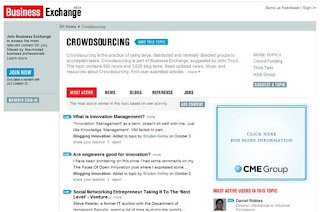She describes her role as “efforts to include readers and incorporate user-generated content (comments, suggestions, longer form opinion pieces) in BW’s journalism, elevating our readers’ participation on the same level as our journalism.” Some of her specific duties are:
• Managing customer engagement; see the links in part 1 for the many activities involved. One important activity is to solicit reader involvement. In part 2 she talks more about the “crowdsourcing” techniques they use.
• Included in customer engagement is the monitoring of reader comments. Each editor also monitors his/her own blog. Monitoring is one way of gauging reader sentiment. It also includes removing comments that do not meet community guidelines.
Crowdsourcing is not my favorite term; it seems to smack of an unruly mob running amok. In spite of that, I wanted to see what they were doing, so I went to the CrowdSourcing page. You may have to go there yourself to read the explanation at the top of the page; the relevant phrase is “using large, distributed and minimally directed groups to accomplish tasks.” Ok. While you are there, note that there’s a Featured User—nice pr—and a block of Tweets on this topic (the main filter appears to be the term “crowdsourcing”). Well done!


When you look further you find that Crowdsourcing is a page on their Business Exchange site (a community site powered by Ning, as far as I can tell). According to the site, “Business Exchange is a Web site that allows users to create business topics, collaboratively aggregate content from the entire Web and connect with other business focused users around these topics.” It has a mind-blowing number of topics (I checked on “Social Marketing,” surprise, surprise!). I registered using my LinkedIn profile. I’m not sure what that adds; it would have been just as easy to fill out the form. However, I may find that I signed up for something else on LinkedIn! Registered users can save content, create a network, and suggest topics as well as simply adding content.
The main take-away is that there’s a lot going on in Business Week’s social space. It’s probably not a luxury, it’s a necessity for a media vehicle that wants to survive in the changing media world. (On that subject, check out the website for Gourmet magazine before it goes away. The home page clearly focuses on content from their writers and editors. There are discussion forums, but there seems to be no serious effort to bring readers into the editorial process.)
Social media is undoubtedly not the silver bullet for survival for magazines, or any other media, for that matter. The more interesting question is whether a given vehicle can survive without enthusiastic reader participation.
While you’re mulling that question, you can learn a lot about community management (note it’s more than monitoring; see a great post by Dion Hinchcliffe) by reading the interviews with Shirley Bradley. Then stay tuned for my next post. I’ve discovered an interesting new community where content creation and monitoring takes on a whole new meaning—and potentially a whole new series of challenges!



No comments:
Post a Comment